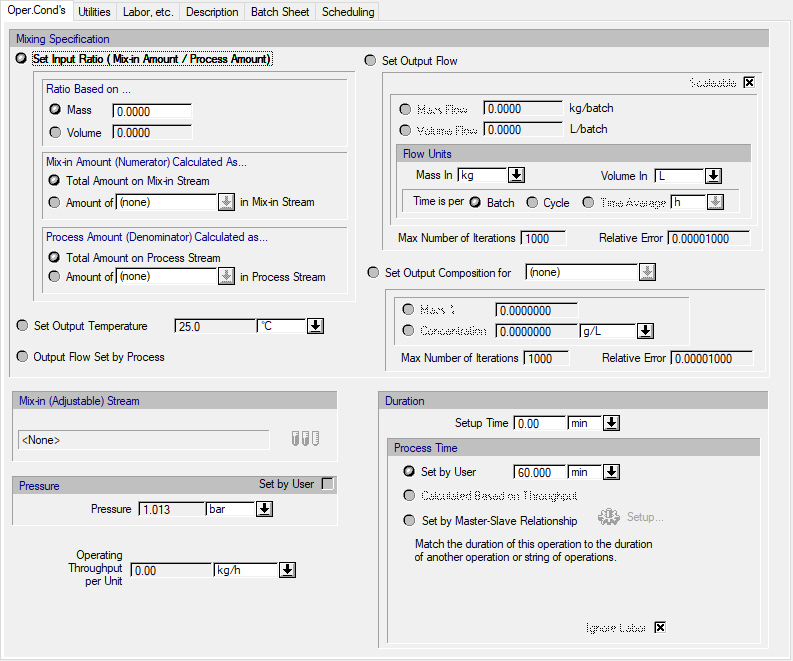

The following table shows a brief description of the variables appearing in this tab. The table also displays their default values and their generally acceptable range:
|
Variable |
Default Value |
Range |
|
|
||
|
◙ Input Ratio Based On Mass |
0.0 |
Positive |
|
◙ Input Ratio Based On Volume |
0.0 |
Positive |
|
○ Mix-in Amount Reference Component |
<None> |
Any Pure Component |
|
○ Process Amount Reference Component |
<None> |
Any Pure Component |
|
◙ Output Temperature (oC) |
25.0 |
Positive |
|
○ Scalable Output Flow |
Yes |
Yes/No |
|
○ Output pH |
7.0 |
|
|
○ Initial Guess Set by User |
No |
Yes/No |
|
◙ Initial Guess |
0.0 |
Positive |
|
◙ Output Mass Flow (kg/h or kg/batch) |
0.0 |
Positive |
|
◙ Output Volume Flow (L/h or L/batch) |
0.0 |
Positive |
|
○ Max Number of Iterations (Set Output Flow Option) |
1000 |
Positive Integer |
|
○ Relative Error (Set Output Flow Option) |
0.00001 |
Positive |
|
○ Output Composition Reference Component |
<None> |
Any Pure Component |
|
○ Output Component Mass % |
0.0 |
0 – 100 |
|
○ Output Component Concentration (g/L) |
0.0 |
Positive |
|
○ Max Number of Iterations |
1000 |
Positive Integer |
|
○ Relative Error |
0.00001 |
Positive |
|
● Mix-in (Adjustable) Stream |
<None> |
Dedicated Input Port |
|
○ Setup Time (min) |
0.0 |
Positive |
|
◙ Process Time (min) |
60.0 |
Positive |
|
○ Ignore Labor? |
Yes |
Yes/No |
|
● Operating Throughput per Unit (kg/h) |
0.0 |
Positive |
Symbol Key: ○ User-specified value (always input); ● Calculated value (always output); ◙ Sometimes input, sometimes output
The following list describes the available specification choices in this tab; for more details on how these are implemented, see Custom Mixing: Modeling Calculations.
•Mixing specifications...
Select one of the following mixing specifications:
a) Set Input Ratio (Mix-in Amount /Process Stream): In this case you can specify either the mass ratio or the volume ratio between the mix-in and the process stream. Furthermore you can ask the numerator of the ratio to be either the mass/volume of the total stream or just one (user-selected) component in the mix-in stream. In the same spirit, the denominator used to calculate the specified ratio, may be either the total mass (or volume) of the process stream or the mass (or volume) of a specific (user-selected) component in that stream.
b) Set Output Flow: In this case you can specify either the mass flow or the volume flow of the output stream.
c) Set Output Temperature: In this case you set the temperature of the output stream. Set Output pH: Specify the desired pH of the output stream. Notice that for this option to be available, the user must enable the “Show pH of Streams and Pure Component pH Data” option has been enabled from the Miscellaneous preferences of the document.
d) Set Output Composition for Component: In this case you specify a reference component and either its outlet concentration or its outlet mass percentage.
e) Output Flow Set by Process: In this case the flow of the output stream is specified by a downstream process.
The model will set the mass flowrate of the adjustable mix-in inlet stream (top stream) in order to meet the mixing specification set by the user. If the mixing specification cannot be met, then a warning message will be displayed during simulation.
•Operating Throughput per Unit...
The operating throughput per unit is based on the mass flowrate of the output stream.
•Scalable Output Flow...
If the selected mixing specification is to set the output flow, specify whether that is scalable with process throughput adjustment. (This implies that if the user chooses to adjust the process throughput by a factor the output flow will also be adjusted by the same factor.)
•Time Reference...
Choose the time reference for flowrate. The flowrate can be specified by the user to be per Batch, per Cycle, or per Time Average. Depending on whether the procedure is in batch mode or continuous, and the whether process is in batch mode or continuous, certain options may not be available. Specifically the availability of time reference flows depending on the mode of procedure / process is:
|
Process Mode |
Procedure Mode |
Time Reference for Flow |
|
|
|
|
|
Batch |
Batch |
Batch / Cycle |
|
Batch |
Continuous |
Batch / Time Average |
|
Continuous |
Continuous |
Time Average |
|
Continuous |
Batch |
Cycle / Time Average |
•Duration Options...
The duration controls appear only if the procedure is in batch mode. In Rating Mode, you can set the process time (and the setup time), allow the process time to be calculated (based on the throughput of the units), or allow the duration to match exactly the duration of another operation either in the same procedure or in another procedure. In Design mode, you must either specify the process time (and the setup time) or allow the duration to match exactly the duration of another operation (either in the same procedure or in another procedure).
If you choose to match the duration of this operation with the duration of another operation, you introduce a master-slave relationship between the two operations. The program will match the setup-time, the process time and the turnaround time of this operation (the ‘slave’) with the corresponding times of the reference operation (the ‘master’ operation). For more on master-slave relationship, see The Scheduling Tab.